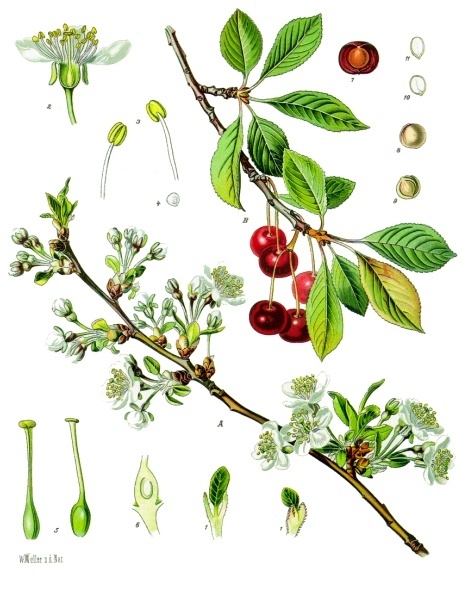- Sour cherry
Taxobox
name = Sour cherry

image_width = 240px
regnum =Plant ae
divisio = Magnoliophyta
classis =Magnoliopsida
ordo =Rosales
familia =Rosaceae
subfamilia =Prunoideae
genus = "Prunus "
subgenus = "Cerasus"
species = "P. cerasus"
binomial = "Prunus cerasus"
binomial_authority = L.The sour cherry "(Prunus cerasus)" is a species of "Prunus " in the subgenus "Cerasus" (cherries), native to much ofEurope and southwestAsia . It is closely related to thewild cherry ("P. avium"), also known as "sweet cherry", but has afruit that is moreacid ic and so is useful primarily for cooking.The tree is smaller than the wild cherry (growing to a height of 4–10 m), has twiggy branches, and its crimson-to-near-black cherries are borne upon shorter stalks.
There are two varieties of the sour cherry: the dark-red
morello cherry and the lighter-red amarelle cherry. ["Webster’s New International Dictionary of the English Language". Springfield, Massachusetts: G. & C. Merriam Co., 1913. See "amarelle" at p. 67.]Cultivation and uses
Cultivated sour cherries were selected from wild specimens of "Prunus cerasus" and the doubtfully distinct "P. acida" from around the Caspian and
Black Sea s, and were known to the Greeks in300 BC . They were also extremely popular with Persians & the Romans who introduced them into Britain long before the1st century AD. The fruit remains popular in modern-dayIran .In Britain, their cultivation was popularised in the
16th century in the time of Henry VIII. They became a popular crop amongst Kentish growers, and by1640 over two dozen namedcultivar s were recorded. In the Americas,Massachusetts colonists planted the first sour cherry, 'Kentish Red', when they arrived.Before the
Second World War there were more than fifty cultivars of sour cherry in cultivation inEngland ; today, however, few are grown commercially, and despite the continuation of named cultivars such as 'Kentish Red', 'Amarelles', 'Griottes' and 'Flemish', only the generic Morello is offered by most nurseries. This is a late-flowering variety, and thus misses more frosts than its sweet counterpart and is therefore a more reliable cropper. The Morello cherry ripens in mid to late summer, towards the end of August in southern England. It is self fertile, and would be a goodpollenizer for other varieties if did it not flower so late in the season.Sour cherries require similar cultivation conditions to
pear s, that is, they prefer a rich, well-drained moistsoil , although they demand morenitrogen andwater than sweet cherries. Trees will do badly if waterlogged, but have greater tolerance of poor drainage than sweet varieties. As with sweet cherries, Morellos are traditionally cultivated by budding onto strong growing rootstocks, which produce trees too large for most gardens, although newer dwarfing rootstocks such as "Colt" and "Gisella" are now available. During spring, flowers should be protected, and trees weeded, mulched and sprayed with seaweed solution. This is also the time when any requiredpruning should be carried out (note that cherries should not be pruned during the dormant winter months). Morello cherry trees fruit on younger wood than sweet varieties, and thus can be pruned harder. They are usually grown as standards, but can be fan trained, cropping well even on cold walls, or grown as low bushes.Sour cherries suffer fewer pests and diseases than sweet cherries, although they are prone to heavy fruit losses from
bird s. In summer, fruit should be protected with netting. When harvesting fruit, they should be cut from the tree rather than risking damage by pulling the stalks. Morello cherries freeze well and retain their flavour superbly.Unlike most sweet cherry varieties, sour cherries are self fertile (sometimes inaccurately referred to as self pollinating) or self pollenizing. Two implications of this are that seeds generally run true to the cultivar, and that much smaller
pollinator populations are needed becausepollen only has to be moved within individual flowers. In areas where pollinators are scarce growers find that stocking beehives in orchards improves yields.ee also
*
Fruit trees
*Fruit tree forms
*Fruit tree propagation
*Pruning fruit trees
*Sour Cherry of Kleparow
*Kirsch
*Kriek , a traditional Belgian beer made with sour cherriesReferences
Wikimedia Foundation. 2010.
